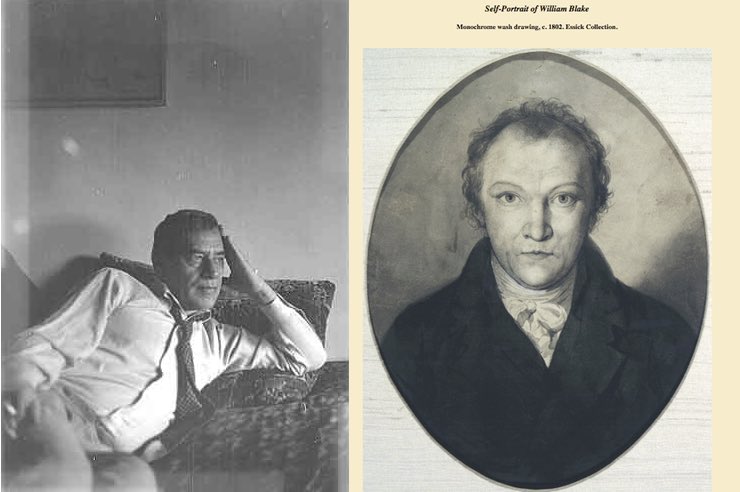There’s a wonderful post, On Klonsky on Blake written by W.C. Bamberger on Zoamorphosis.com. That website focuses on the work of poet/artist William Blake.
What should my eyes behold, when surfing to find why viewers were accessing my page on Milton Klonsky, but (first) reviews of a play in which Milton’s biography was distorted – by Romulus Linney. The play, Klonsky and Schwartz, took off from the playwright’s belated discovery that Milton was the one who picked up Delmore Schwartz’s body from the morgue. Delmore was the roman a clef inspiration for Saul Bellow’s central figure in Humboldt’s Gift. Schwartz, who was at one point on the top of the world artistically, fell and died a pauper. In fact, his papers were discovered in his apartment afterwards and published. A true story as if out of the nineteenth century.
Anyway, yes Schwartz was a friend of Klonsky, and the playwright, who had had casual drinks with Milton in a bar, did not know this. He expected that Milton would just blurt out his relationship with Delmore, and the opposite was the case. As Klonsky rarely talked offhand about his close ties with the British poet Auden (who, though gay, married his ex-wife; hmmm; Milton told me it was to get closer to him), he did not just namedrop in this case either. Anyway, there was much more to the story of why Milton picked up the body. (Someone had to.) But Linney knew none of it, which gave him a chance to make everything up!
Be all this as it may, based on this flimsy discovery, the playwright turned Milton’s persona upside down, inventing it and calling it “true to life.” No one was still around to refute him. But Bamberger was incredulous. From reading Klonsky’s work, he felt the picture didn’t add up – at all. And he was right.
The playwright had an opening – because Klonsky left so many mysteries. But I had known him personally and was aghast. He was unrecognizable, whereas an eyewitness account of him, in Views of a Nearsighted Cannoneer, reprinted in What’s THIS Cat’s Story by his close friend Seymour Krim, said (accurately):
There was no childish competitiveness on the part of Klonsky vis-à-vis these stern [famous literary] figures, it was not to test himself in the ring of literature that he braved or broke the standards erected by these Twentieth-Century culture heroes (like my friend Mailer, who puts courage above reality) but rather it was because he had truly been born with a special line hooked into the inner switchboard of existence . . . in [an] extraordinary way [he] made abstract concepts real as your hand—like a religious Poe and possessed a spiritual life so grave and proportionate that only the superbest adult utterance could do it justice.”
Bamberger concludes:
Klonsky died in 1982, but he hasn’t been entirely forgotten. He even appears as a character in Klonsky and Schwartz, a two-person play by Romulus Linney that debuted in 2005. “Schwartz” is Delmore Schwartz, the briefly brilliant, long-dimming poet who was Klonsky’s friend for years. In the play the Klonsky character suffers both from feeling that he is a lesser writer than his friend and from trying to keep Schwartz’s madness from killing him. But there is nothing of the particular Klonsky in the play; the characters could have been given any two writers’ names with even roughly the same relationship and nothing would be lost. Is it romanticizing, I wonder, to believe that Klonsky, a contrary and fiercely individual mind, would have preferred complete oblivion to a bland survival in name only?
I posted a reply to On Klonsky on Blake written by W.C. Bamberger here. His own post is well worth reading. Also, it adds balance and justice to Klonsky’s universe, that by peering into what a person left behind, one might challenge a play that has been performed around the country – porporting to describe that author. But the facts don’t jive. The evidence doesn’t. And without ever meeting Milton, Bamberger acted on his suspicion.
In fact, many quotes by Milton, which reveal who he was, woefully absent in the play, appear in his very own mouth in the Keep This Quiet! series. Especially in Keep THIS Quiet Too! where I visited his apartment once a year, in passing through New York, with a layover en route to NC from Morocco, I record theatrically, in scenes, the actual Milton of my visits. The made-up dialogue in the play seems apparently, I wager, more reflective of something in the author himself than this brilliantly alive, quipping character in my book, who is presented – there – true to life. Indeed. May truth always “out,” and no person who is “a mystery” become the property of another after he and his friends are all gone. May he sprinkle pieces of his truth behind, that someone can rescue his history through. This is important not just personally, for him, but because that way we receive what he truly left behind, not a speculation filling in because he was silent on his biography himself. Fortunately, or fatefully, Krim took down his biography till 1960 and I stepped in and – fatefully – recorded his sayings from that time on. Shall I say Hallelujah? Watch his brilliance come to life in those scenes in his apartment, the real “play” of his uniqueness.
